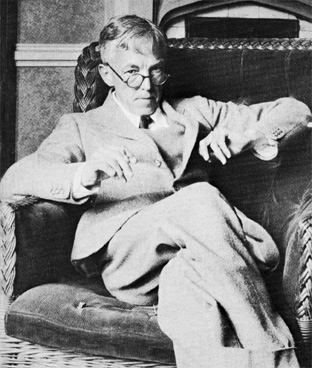<Back to Index>
- Mathematician Godfrey Harold Hardy, 1877
- Author Charles John Huffam Dickens, 1812
- Empress of Russia Anna Ivanovna, 1693

G. H. (Godfrey Harold) Hardy FRS (February 7, 1877 Cranleigh, Surrey, England – December 1, 1947 Cambridge, Cambridgeshire, England) was a prominent English mathematician, known for his achievements in number theory and mathematical analysis. Non-mathematicians usually know him for A Mathematician's Apology, his essay from 1940 on the aesthetics of mathematics. The Apology is often considered one of the best insights into the mind of a working mathematician written for the layman. His relationship as mentor, from 1914 onwards, of the Indian mathematician Srinivasa Ramanujan has
become celebrated. Hardy almost immediately recognized Ramanujan's
extraordinary albeit untutored brilliance, and Hardy and Ramanujan
became close collaborators. In an interview by Paul Erdős,
when Hardy was asked what his greatest contribution to mathematics was,
Hardy unhesitatingly replied that it was the discovery of Ramanujan. He
called their collaboration "the one romantic incident in my life." G.H. Hardy was born 7 February 1877, in Cranleigh, Surrey, England, into a teaching family. His father was Bursar and Art Master at Cranleigh School; his mother had been a senior mistress at Lincoln Training College for teachers. Both parents were mathematically inclined. Hardy's
own natural affinity for mathematics was perceptible at a young age.
When just two years old, he wrote numbers up to millions, and when
taken to church he amused himself by factorizing the numbers of the hymns. After schooling at Cranleigh, Hardy was awarded a scholarship to Winchester College for his mathematical work. In 1896 he entered Trinity College, Cambridge. After only two years of preparation he was fourth in the Mathematics Tripos examination.
Years later, Hardy sought to abolish the Tripos system, as he felt that
it was becoming more an end in itself than a means to an end. While at
university, Hardy joined the Cambridge Apostles, an elite, intellectual secret society. As the most important influence Hardy cites the self-study of Cours d'analyse de l'École Polytechnique by the French mathematician Camille Jordan, through which he became acquainted with the more precise mathematics tradition in continental Europe.
In 1900 he passed part II of the tripos and was awarded a fellowship.
In 1903 he earned his M.A., which was the highest academic degree at
English universities at that time. From 1906 onward he held the
position of a lecturer where teaching six hours per week left him time
for research. In 1919 he left Cambridge to take the Savilian Chair of Geometry at Oxford in the aftermath of the Bertrand Russell affair during World War I. He returned to Cambridge in 1931, where he was Sadleirian Professor until 1942. From 1911 he collaborated with J. E. Littlewood, in extensive work in mathematical analysis and analytic number theory. This (along with much else) led to quantitative progress on the Waring problem, as part of the Hardy-Littlewood circle method, as it became known. In prime number theory, they proved results and some notable conditional results. This was a major factor in the development of number theory as a system of conjectures; examples are the first and second Hardy–Littlewood conjectures.
Hardy's collaboration with Littlewood is among the most successful and
famous collaborations in mathematical history. In a 1947 lecture, the
Danish mathematician Harald Bohr reported
a colleague as saying, "Nowadays, there are only three really great
English mathematicians: Hardy, Littlewood, and Hardy–Littlewood." Hardy is also known for formulating the Hardy–Weinberg principle, a basic principle of population genetics, independently from Wilhelm Weinberg in 1908. He played cricket with the geneticist Reginald Punnett who introduced the problem to him, and Hardy thus became the somewhat unwitting founder of a branch of applied mathematics. Aside from formulating the Hardy-Weinberg principle in population genetics, his famous work on integer partitions with his collaborator Ramanujan, known as the Hardy-Ramanujan asymptotic formula,
has been widely applied in physics to find quantum partition functions
of atomic nuclei (first used by Niels Bohr) and to derive thermodynamic
functions of non-interacting Bose-Einstein systems.
Though Hardy wanted his maths to be "pure" and devoid of any
application, much of his work has found applications in other branches
of science.
Socially he was associated with the Bloomsbury group and the Cambridge Apostles; G. E. Moore, Bertrand Russell and J. M. Keynes were friends. He was an avid cricket fan and befriended the young C. P. Snow who was one also. He was at times politically involved, if not an activist. He took part in the Union of Democratic Control during World War I, and For Intellectual Liberty in the late 1930s. Hardy was an atheist.
Apart from close friendships, he had a few platonic relationships with
young men who shared his sensibilities. He was a life-long bachelor,
and in his final years he was cared for by his sister. Hardy
was extremely shy as a child, and was socially awkward, cold and
eccentric throughout his life. During his school years he was top of
his class in most subjects, and won many prizes and awards but hated
having to receive them in front of the entire school. He was
uncomfortable being introduced to new people, and could not bear to
look at his own reflection in a mirror. It is said that, when staying
in hotels, he would cover all the mirrors with towels.